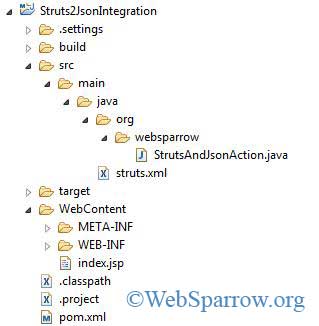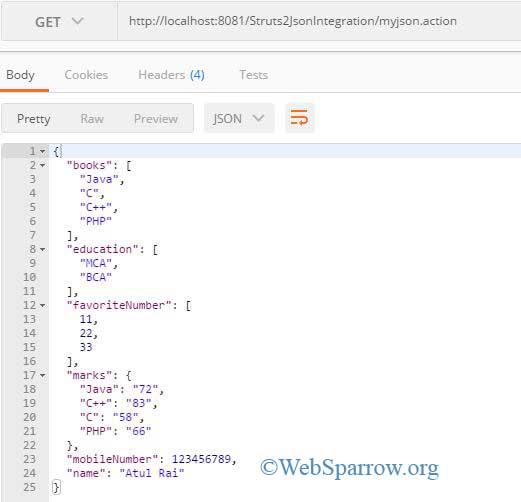Struts 2 and JSON Integration Example
In this Struts 2 tutorial, we get the JSON response through our Struts 2 application. JSON is the most popular way to data-interchange.
In this example, we are trying to make the code super simple for easy to understand.
Software Used
- Eclipse IDE
- Tomcat 8
- JDK 8
Get the JAR Dependencies
<dependencies>
<dependency>
<groupId>org.apache.struts</groupId>
<artifactId>struts2-core</artifactId>
<version>2.1.8</version>
</dependency>
<dependency>
<groupId>org.apache.struts</groupId>
<artifactId>struts2-json-plugin</artifactId>
<version>2.1.8</version>
</dependency>
</dependencies>struts2-json-plugin-2.x.x.jar file allows you to serialize the Action class attribute which has setters into a
JSON object.
Project Structure in Eclipse

Add Struts 2 Filter
Define the struts 2 filters into web.xml.
<?xml version="1.0" encoding="UTF-8"?>
<web-app xmlns:xsi="http://www.w3.org/2001/XMLSchema-instance" xmlns="http://xmlns.jcp.org/xml/ns/javaee"
xsi:schemaLocation="http://xmlns.jcp.org/xml/ns/javaee http://xmlns.jcp.org/xml/ns/javaee/web-app_3_1.xsd" id="WebApp_ID" version="3.1">
<display-name>Struts2JsonIntegration</display-name>
<welcome-file-list>
<welcome-file>index.jsp</welcome-file>
</welcome-file-list>
<filter>
<filter-name>struts2</filter-name>
<filter-class>org.apache.struts2.dispatcher.ng.filter.StrutsPrepareAndExecuteFilter</filter-class>
</filter>
<filter-mapping>
<filter-name>struts2</filter-name>
<url-pattern>/*</url-pattern>
</filter-mapping>
</web-app>Create Action Class
In this class data converted into JSON format.
package org.websparrow;
import java.util.ArrayList;
import java.util.HashMap;
import java.util.List;
import java.util.Map;
import com.opensymphony.xwork2.Action;
public class StrutsAndJsonAction {
private String name = "Atul Rai";
private String[] education = { "MCA", "BCA" };
private int mobileNumber = 123456789;
private int[] favoriteNumber = { 11, 22, 33 };
private Map<String, String> marks = new HashMap<String, String>();
private List<String> books = new ArrayList<String>();
public StrutsAndJsonAction() {
books.add("Java");
books.add("C");
books.add("C++");
books.add("PHP");
marks.put("Java", "72");
marks.put("C", "58");
marks.put("C++", "83");
marks.put("PHP", "66");
}
public String execute() {
return Action.SUCCESS;
}
public String getName() {
return name;
}
public void setName(String name) {
this.name = name;
}
public String[] getEducation() {
return education;
}
public void setEducation(String[] education) {
this.education = education;
}
public int getMobileNumber() {
return mobileNumber;
}
public void setMobileNumber(int mobileNumber) {
this.mobileNumber = mobileNumber;
}
public int[] getFavoriteNumber() {
return favoriteNumber;
}
public void setFavoriteNumber(int[] favoriteNumber) {
this.favoriteNumber = favoriteNumber;
}
public List<String> getBooks() {
return books;
}
public void setBooks(List<String> books) {
this.books = books;
}
public Map<String, String> getMarks() {
return marks;
}
public void setMarks(Map<String, String> marks) {
this.marks = marks;
}
}Map Action Class
Map your action class in struts.xml. You will need to set package extends="json-default" result type is json.
<?xml version="1.0" encoding="UTF-8" ?>
<!DOCTYPE struts PUBLIC
"-//Apache Software Foundation//DTD Struts Configuration 2.0//EN"
"http://struts.apache.org/dtds/struts-2.0.dtd">
<struts>
<constant name="struts.devMode" value="true" />
<package name="default" namespace="/" extends="json-default">
<action name="myjson" class="org.websparrow.StrutsAndJsonAction">
<result type="json" />
</action>
</package>
</struts>Output:
To run the application start your server and hit this URL in address bar http://localhost:8081/Struts2JsonIntegration/myjson.action. To get the JSON data in the arranged form use the Chrome Postman.

Download Source Code – struts2-and-json-integration-example.zip